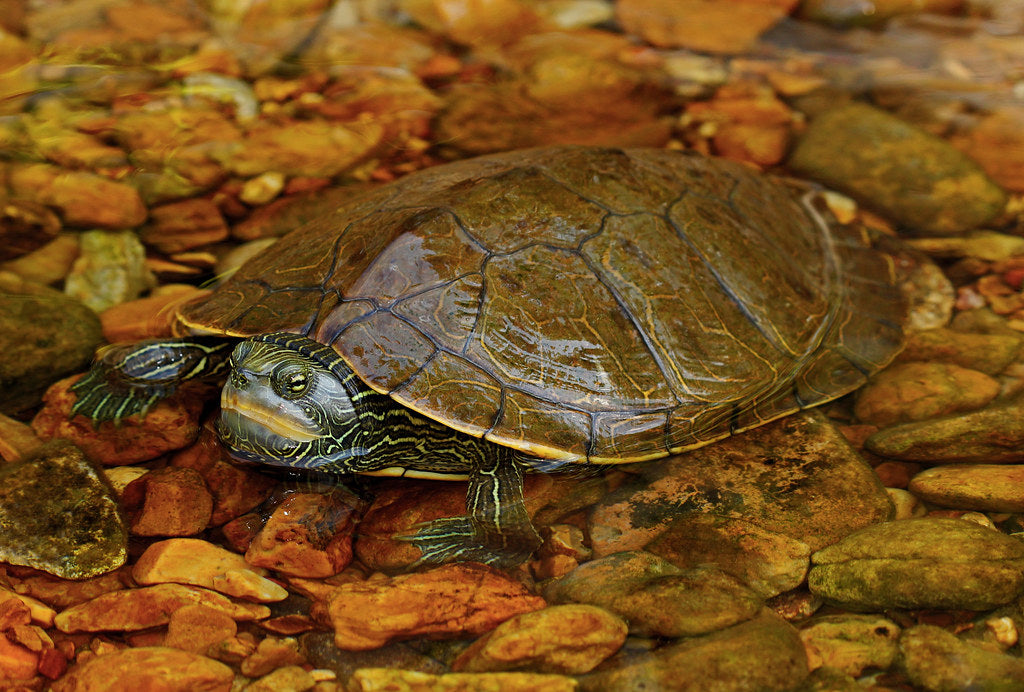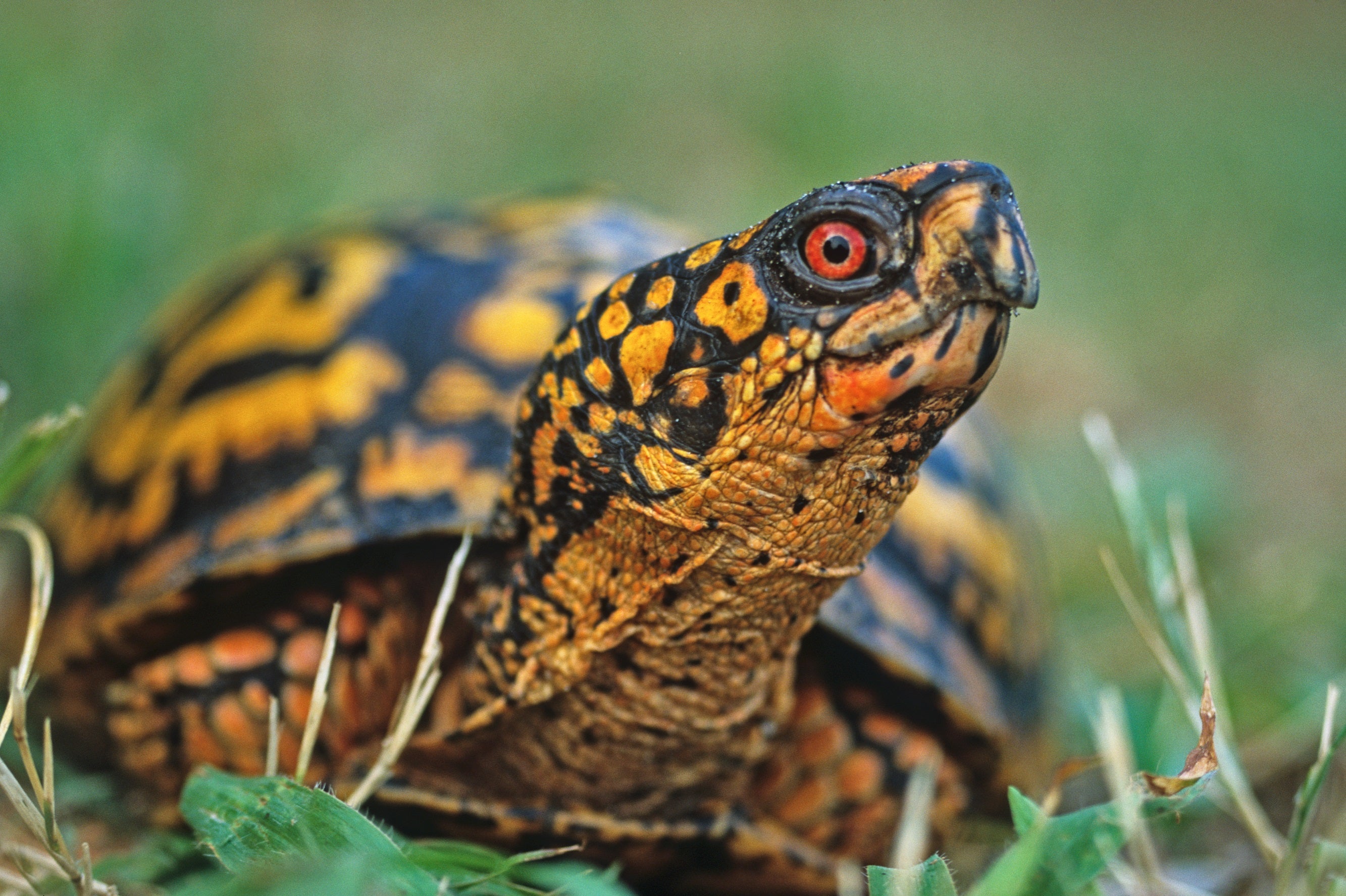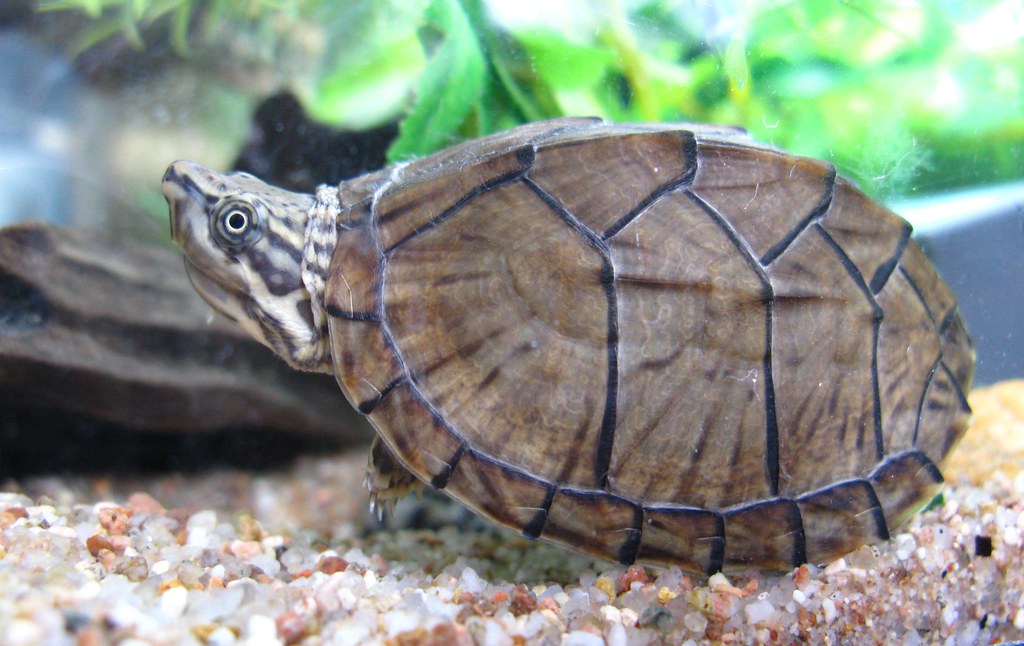The common map turtle (Graptemys geographica) is a medium-large, semi-aquatic, diurnal reptile native to the northeastern quadrant of the United States. They prefer large bodies of water such as rivers, ponds, and lakes, with plenty of available basking sites.
Common map turtles have an average adult length of 3.5-6.5” for males and 7-10.5” for females. They have an olive green/brown, keeled shell with a pattern of thin, pale yellow lines, and a pale yellow plastron. The skin is similarly colored and patterned to the shell, and the eyes are yellow with a dark transverse bar through the pupil. They also have a small triangular marking behind each eye.
Common map turtles can make good pets when captive-bred and cared for appropriately. However, due to their size and husbandry requirements, they are at least intermediate-level pet reptiles. With good care, they are likely to live at least 15-20 years.
Note: Map turtles may be very common in the US, but that is not a reason to take one from the wild! If you want a pet map turtle, purchase one from a breeder or adopt one from a rescue or your local classifieds. Never take reptiles from the wild!
How much space do common map turtles need?
Common map turtles are large and fairly active, and they’re also amphibious, so they need an enclosure that will appropriately accommodate their preferred lifestyle. The enclosure should be large enough to provide at least 10 gallons of water per inch of the turtle’s expected adult length. So if you have a male, you will need at least 65 gallons of water. If you have a female, you will need at least 105 gallons of water. Water depth should be 4-6” for hatchlings, but can be much deeper for juveniles and adults, as this species is a strong swimmer.
Map turtles tend to do well when housed outdoors where local climate permits, even if it’s just during part of the year (they should not be allowed to hibernate outdoors). This is a convenient way to provide your turtle with a generously-sized pond and “free” heating and lighting. If housing your map turtle outdoors, make sure the enclosure is well secured against both escape and potential predators.
It’s best not to house multiple map turtles in the same enclosure. An exception can be made for large outdoor ponds.
Do common map turtles need UVB?
Map turtles require regular exposure to high-quality UVB in order to maintain optimal health and wellbeing. Providing UVB lighting to your turtle gives them all of the vitamin D that their body needs, stimulates better appetite and activity, and strengthens the immune system, as well as other benefits.
The best UVB bulbs for common map turtles are:
- Zoo Med Reptisun T5 HO 5.0
- Arcadia Forest 6%
The UVB bulb should be half the length of the enclosure and housed in a reflective fixture like the Arcadia ProT5 or Vivarium Electronics. Place the lamp close to the heat lamps, about 13-14” above the basking platform if there’s no mesh obstruction, but 8-11” away if there is mesh.
It’s also a good idea to provide a strong LED or T5 HO 6500K daylight lamp for additional illumination. This helps better replicate daylight and is also good for any live plants you may be using.
UVB bulbs decay over time, so don’t forget to replace your bulb every 12 months to maintain good performance. If you are housing your turtle outdoors in an appropriate climate, supplementary lighting is not required.
Lights should be on for 14 hours/day during summer and 10 hours/day during winter.
What basking temperatures do common map turtles need?
Map turtles are ectotherms, which means that they rely on the variable temperatures of their environment to help regulate their metabolism and stay healthy. Here’s the range of temperatures a map turtle’s indoor enclosure should offer:
- Basking surface: 100-110°F
- Water (juveniles): 78-80°F
- Water (subadults/adults): 72-76°F
Measure basking temperature with a digital probe thermometer, and water temperature with a high-quality aquarium thermometer.
A good way to warm the basking area is with a couple of halogen flood heat lamps clustered on one side of the enclosure and positioned over a sturdy basking branch or rock. Do not use ceramic heat emitters (CHEs), red bulbs, or blue bulbs, as these are not as effective. Increase the wattage if they’re too cool, and use a plug-in lamp dimmer if they’re too warm.
If you need to heat the water, use a high-quality aquarium heater rated for at least the maximum volume of water in the enclosure.
If you are housing your turtle outdoors, supplementary heating should not be required. However, they will need to be brought indoors for winter hibernation from approximately November to April.
What water conditions do common map turtles need?
Map turtles are semi-aquatic, which means that most of the enclosure should be water. This water must be kept clean at all times in order to keep your turtle healthy (and to keep the aquarium attractive). The most efficient way to do this is with a combination of excellent filtration and regular water changes.
Aquatic turtles are fairly messy creatures, so you will need a canister-style filter capable of handling at least 2-3x the amount of water in the enclosure. So, if you have an aquarium or pond with 105 gallons of water, you will need a filter rated for at least 210 gallons of water. Don’t settle for the cheapest filter you can find — this is one aspect of your turtle’s enclosure not to skimp on!
Once every 1-2 weeks, remove and replace approximately 30% of the aquarium/pond’s total water volume. This helps minimize buildup of toxic compounds in the water that a filter is unable to resolve. To make the job easier, use a siphon or water pump.
Both indoor and outdoor turtle ponds require filtration and water changes.
Conditioning the water to remove chlorine and chloramines with a reptile-safe product such as Zoo Med ReptiSafe may be beneficial.
What décor can you use in a common map turtle terrarium?
The most essential piece of “décor” you will need in your turtle’s enclosure is going to be a basking platform. Ideally, this should be a partitioned-off area of land where the turtle can climb out of the water, bask, explore, and burrow. If that is not possible, securely stacked rocks, a large piece of wood, or a commercially-available turtle basking platform can be used as a basking location. The turtle should be able to easily climb onto the platform, and it must be large enough for the turtle to remove its entire body from the water and walk around a bit.
Aside from the basking area, there are additional ways you can increase the enclosure’s functionality and general attractiveness. Here are some ideas:
- live/artificial plants
- mopani wood
- hollow logs
- fine-particle aquatic substrate (ex: sand)
Make sure your turtle has access to places where it can hide from view as needed.
Substrate is optional. It does make the enclosure more attractive (particularly indoor aquariums), but it must be cleaned with a siphon regularly. Sand, crushed coral, and river pebbles are all appropriate options.
What do common map turtles eat?
Map turtles are omnivores, which means that they need to eat a balanced diet of both plant- and animal-based foods to get the nutrition that they need. Here is a general feeding schedule to follow:
Common map turtles younger than 6 months:
- 50% protein / 50% vegetables
- protein food or pellets daily
- vegetable food daily
Common map turtles between 6-12 months:
- 50% protein / 50% vegetables
- protein food or pellets every other day
- vegetable food daily
Common map turtles older than 1 year:
- 25% protein / 75% vegetables
- protein food or pellets 2-3x/week
- vegetable food daily
A portion of chopped/shredded vegetables should be roughly the same size as the turtle’s shell. A portion of pellets or protein food should be roughly the same size as the turtle’s head.
Animal-based foods for common map turtles: crickets, earthworms, dubia roaches, freeze-dried shrimp/krill, frozen bloodworms, blackworms, silkworms, snails, guppies, mollies, platies, mosquito fish, crayfish, mussels, snails
Vegetable foods for common map turtles: collard greens, dandelion greens + flowers, endive, green leaf lettuce, kale, red leaf lettuce, romaine lettuce, raw grated squash, carrots, green beans, raw grated sweet potato, duckweed, filamentous algae
Pellets for common map turtles: Omega One Juvenile Turtle Pellets, Omega One Adult Turtle Sticks, Tetra ReptoMin, Zoo Med Natural Aquatic Turtle Food, Mazuri Aquatic Turtle Diet
For extra calcium, your turtle should have access to a cuttlebone or calcium block at all times.
Do common map turtles like to be handled?
As a general rule, turtles do not like to be handled. Keep handling to a minimum unless it is absolutely necessary for inspection or transportation (ex: going to the vet for a checkup). If you would like to interact with your turtle, try hand-feeding it with a pair of feeding tongs.
*This care sheet contains only very basic information. Although it’s a good introduction, please do further research with high-quality sources to obtain additional information on caring for this species.
"Common Map Turtle (Graptemys geographica)" by 2ndPeter is licensed under CC BY 2.0




Leave a comment
This site is protected by hCaptcha and the hCaptcha Privacy Policy and Terms of Service apply.